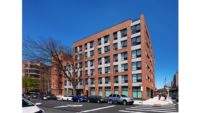The acclaimed architecture, interiors and urban design practice Body Lawson Associates Architects and Planners has unveiled their design for an innovative new affordable housing complex in Manhattan’s West Harlem for low- and moderate-income families. Equipped with community-enhancing designs and amenities to offer a uniquely upscale experience, the new 169-unit building with a memorable, rhythmic cladding, which began construction last fall, is the second phase of a major 330-unit development.
Named after the Pan-African exponent and political activist, the $200 million multifamily complex Marcus Garvey Village is being developed by Carthage Real Estate Advisors, led by its president Edward Poteat.
With a market rate building designed by Fischer+Makooi Architects, the second phase, designed by Body Lawson Associates at 124th Street in Manhattan between 7th Avenue and 8th Avenue, brings a range of affordable living options in a community atmosphere with engaging amenities. When complete, the second phase will offer a mix of studios and one- and two-bedroom units, along with a 3,000-square-foot community facility, with 3,500 square feet of retail space and a new LGBTQ center in the adjacent building next door.
In these ways, the project deeply reflects the focus by Body Lawson Associates and its founder, Victor F. Body-Lawson, FAIA, on prioritizing the neighborhood’s voice and engagement, as the firm pushes to reevaluate how affordable housing can be all-purpose and dimensional in ways that actively benefit their communities. Body Lawson Associates has completed dozens of residential works in the same neighborhood over the past three decades.
Other recent large-scale residential projects by Body Lawson Associates in West Harlem include the mixed-use Dr. Muriel Petione Plaza with 65 senior apartments on West 146th Street. Elsewhere in New York City, Body Lawson Associates has designed the innovative Home Street Residences, with 62 apartments for seniors and a ground-floor teen community center, as well as the first phase of The Peninsula in the Bronx, including 184 affordable housing units and a job-creating light industrial complex on a large campus with open green space. The American Institute of Architects has recognized Body-Lawson for this work, elevating him to its College of Fellows and, through their New York Chapter, named him the 2021 Leader in Housing.
“As gentrification challenges West Harlem, we feel especially inspired to create this design that uplifts the local community’s resilience and calls for change in a shifting post-pandemic world,” said Body-Lawson, the Nigeria-born architect, artist and educator with over 30 years of experience in promoting economic revitalization and community engagement. “We also relied on our wide-ranging practice of efficiently creating smart buildings that are environmentally sustainable through their architectural concept and urban plan.”
The 19-story, 145,000-square-foot building, designed as part of the overall housing complex, is rising at 212 West 124th Street, with Body Lawson Associates serving as design architect and architect of record for the work, in partnership with production services by Fischer + Makooi Architects. In addition to an array of resident amenities, BLA and Carthage Real Estate Advisors reflect the culture of the neighborhood, adding dedicated spaces for the first-floor LGBTQ center and rooms reserved for civic uses, including local Community Board meetings. All of the 169 new apartments will be affordable for low- and moderate-income occupants, and many will offer impressive views of Harlem and the Manhattan skyline to the south.
The striking façades are clad with a distinct, charcoal gray brick veneer complemented by a scored stucco-like finish, unlike any other in the surrounding area. Undergirding the memorable exterior are highly efficient and economical construction approaches to craft an uplifting, sustainable and resilient cornerstone for this urban community. Additional amenities include an outdoor recreation terrace, storage, laundry rooms, lounge spaces, a recreation room, and on-site car and bike parking.

Photo courtesy of Body Lawson Associates
“Our mission with Marcus Garvey Village has always been to create a building that celebrates the spirit of this world-renowned neighborhood,” said Poteat, a force behind affordable housing in Harlem for over two decades and a professor at Columbia University. “This project sets a new paradigm for development in the place where I grew up and offers a model of responsible gentrification which is controlled and ultimately positive for the community.”
“We aim to be a powerhouse of accommodation, convenience and community spirit through the unification of commercial, residential and recreational spaces that promise to serve and support all unique individuals,” Body-Lawson added. Even the façade design, he added, is created to contrast the local fabric and offer its own identity, “further helping to elevate rather than erase Harlem’s cultural significance and vibrancy.”
Inspired by the political leader who fought to unify all people of African descent through nationalism and the celebration of African history and culture, Marcus Garvey Village aspires to create opportunities for the community to advance and collaborate, with an architectural design serving to remove social boundaries and foster communal unity. A contribution of $2 million from local nonprofit organization West Harlem Development Cooperation has added to Marcus Garvey Village and Harlem’s promising future.









